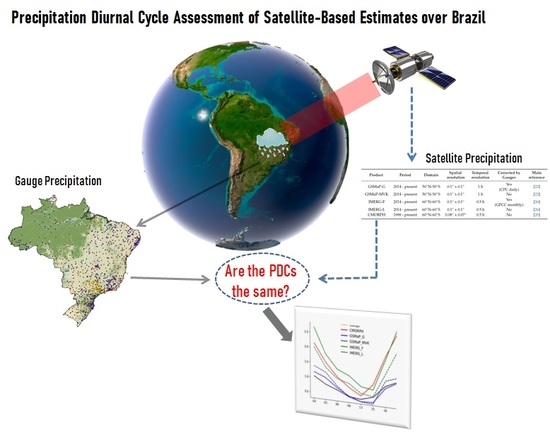Precipitation Diurnal Cycle Assessment of Satellite-Based Estimates over Brazil
Abstract
1. Introduction
2. Study Area and Data
2.1. Study Area
2.2. Ground Gauge and Quality Control
- Missing and unrealistic values were detected from the reference dataset. In some cases like INMET, CEMIG and SIMEPAR data are flagged as 9999.99 while the other networks use a spurious value (i.e., 650 mmh−1);
- A threshold between 10 mmh−1 and 120 mmh−1 was established for convective rainfall (also adopted at SIMEPAR) to apply specific quality control tests, according to [16];
- For rainfall rates within this interval, the physical characteristics of the convective clouds were compared with the correspondent satellite imagery [17] using different channels (mainly infrared and visible, when available) from GOES 13 and 16. This imagery was provided by the Satellite Division and Environmental Systems DSA/INPE;
- The reference dataset, with different time resolution, were accumulated for three hour periods following the WMO guidelines (i.e., 00-03 UTC; 03-06 UTC; and so on);
- Daily values (12:00-12:00 UTC) were compared with accumulated values from the previous step at each station to satisfy INPE’s quality control tests [1].
2.3. Satellite-Based Precipitation Estimates (SPE)
3. Methodology
3.1. Data Standardization
3.2. Cluster Analysis
3.3. Statistical Indices
4. Results
Precipitation Diurnal Cycle Comparison
5. Discussion and Conclusions
Author Contributions
Funding
Acknowledgments
Conflicts of Interest
Abbreviations
| PDC | Precipitation Diurnal Cycle |
| TC | Thermal Convection |
| QC | Quality Control |
| SPE | Satellite-based precipitation estimates |
| IWP | Ice Water Path |
| LB | Local Breezes |
| LT | Local Time |
| SL | Squall Lines |
| NE | Northeast |
| SE | Southeast |
| N | North |
| CS | Convective Systems |
| TRMM | Tropical Rainfall Measuring Mission |
| DPR | Dual-frequency Precipitation Radar |
| GPM | Global Precipitation Measurement |
| ITCZ | Intertropical Convergence Zone |
| SACZ | South Atlantic Convergence Zone |
| CEMIG | Companhia Energética de Minas Gerais |
| SIMEPAR | Sistema Meteorológico do Paraná |
| IAC | Agronomic Institute |
| ANA | National Water Agency |
| INMET | National Institute of Meteorology |
| FS | Frontal Systems |
| EW | Easterly Waves |
| CC | Pearson’s Correlation Coefficient |
| RMSE | Root Mean Square Error |
| SD | Standard Deviation |
| DPA | Daily Precipitation Amplitude |
| GOES | Geostationary Operational Environmental Satellite |
References
- Rozante, J.R.; Vila, D.A.; Chiquetto, J.B.; Fernandes, A.d.; Alvim, D.S. Evaluation of TRMM/GPM blended daily products over Brazil. Remote Sens. 2018, 10, 882. [Google Scholar] [CrossRef]
- Marengo, J.; Liebmann, B.; Grimm, A.; Misra, V.; Dias, P.S.; Cavalcanti, I.; Carvalho, L.; Berbery, E.; Ambrizzi, T.; Vera, C. Recent developments on the south american monsoon system. Int. J. Climatol. 2012, 32, 1–21. [Google Scholar] [CrossRef]
- Hossain, F.; Lettenmaier, D.P. Flood prediction in the future: Recognizing hydrologic issues in anticipation of the Global Precipitation Measurement mission. Water Resour. 2006, 42, 1–5. [Google Scholar] [CrossRef]
- Janowiak, J.E.; Kousky, V.E.; Joyce, R.J. Diurnal cycle of precipitation determined from the CMORPH high spatial and temporal resolution global precipitation analyses. J. Geophys. Res. Atmos. 2005, 110. [Google Scholar] [CrossRef]
- Westra, S.; Alexander, L.V.; Zwiers, F.W. Global increasing trends in annual maximum daily precipitation. J. Clim. 2013, 26, 3904–3918. [Google Scholar] [CrossRef]
- Roca, R.; Alexander, L.V.; Potter, G.; Bador, M.; Jucá, R.; Contractor, S.; Bosilovich, M.G.; Cloché, S. FROGS: A daily 1∘× 1∘ gridded precipitation database of rain gauge, satellite and reanalysis products. Earth Syst. Sci. Data 2019, 11, 1017–1035. [Google Scholar] [CrossRef]
- Leong, T.M.; Zheng, D. Assessment of GPM and TRMM precipitation products over Singapore. Remote Sens. 2017, 9, 720. [Google Scholar]
- Hsu, K.; Gao, X.; Sorooshian, S.; Gupta, H.V. Precipitation estimation from remotely sensed information using artificial neural networks. J. Appl. Meteorol. 1997, 36, 1176–1190. [Google Scholar] [CrossRef]
- Tang, G.; Zeng, Z.; Long, D.; Guo, X.; Yong, B.; Zhang, W.; Hong, Y. Statistical and hydrological comparisons between TRMM and GPM level-3 products over a midlatitude basin: Is day-1 IMERG a good successor for TMPA 3B42V7? J. Hydrometeorol. 2016, 17, 121–137. [Google Scholar] [CrossRef]
- Mota, G.V. Characteristics of rainfall and precipitation features defined by the tropical rainfall measuring mission over South America. Univ. Utah 2003, 201, 4590–4605. [Google Scholar]
- Brito, S.S.D.B.; Oyama, M.D. Daily cycle of precipitation over the northern coast of Brazil. J. Appl. Meteorol. Climatol. 2014, 53, 2481–2502. [Google Scholar] [CrossRef]
- Giles, J.A.; Ruscica, R.C.; Menéndez, C.G. The diurnal cycle of precipitation over South America represented by five gridded datasets. Int. J. Climatol. 2019. [Google Scholar] [CrossRef]
- Skofronick-Jackson, G.; Petersen, W.A.; Berg, W.; Kidd, C.; Stocker, E.F.; Kirschbaum, D.B.; Kakar, R.; Braun, S.A.; Huffman, G.J.; Iguchi, T.; et al. The global precipitation measurement (GPM) mission for science and society. Bull. Am. Meteorol. 2017, 98, 1679–1695. [Google Scholar] [CrossRef] [PubMed]
- Skofronick-Jackson, G.; Berg, W.; Kidd, C.; Kirschbaum, D.B.; Petersen, W.A.; Huffman, G.J.; Takayabu, Y.N. Global Precipitation Measurement (GPM): Unified Precipitation Estimation from Space. Remote Sens. Clouds Precip. 2018, 175–193. [Google Scholar]
- Reboita, M.S.; Gan, M.A.; Rocha, R.P.D.; Ambrizzi, T. Regimes de precipitação na América do Sul: Uma revisão bibliográfica. Rev. Bras. Meteorol. 2010, 25, 185–204. [Google Scholar] [CrossRef]
- Tenório, R.S.; Cristina da Silva Moraes, M.; Hyuk Kwon, B. Raindrop distribution in the Eastern Coast of Northeastern Brazil using disdrometer data. RBMET 2010, 10, 415–426. [Google Scholar] [CrossRef][Green Version]
- Ahrens, C. Meteorology today: An introduction to weather, climate, and the environment. In Meteorology Today, 6th ed.; Belmont Publishing House: Belmont, TN, USA, 2009; pp. 116–120. [Google Scholar]
- Wilks, D.S. Statistical Methods in the Atmospheric Sciences. In International Geophysics Series, 3rd ed.; Academic Press Publishing House: San Diego, CA, USA, 2011; pp. 133–141. [Google Scholar]
- Joyce, R.J.; Janowiak, J.E.; Arkin, P.A.; Xie, P. Cmorph: A method that produces global precipitation estimates from passive microwave and infrared data at high spatial and temporal resolution. J. Hydrometeorol. 2004, 5, 487–503. [Google Scholar] [CrossRef]
- Ushio, T.; Okamoto, K.; Kubota, T.; Hashizume, H.; Shige, S.; Noda, S.; Iida, Y.; Aonashi, K.; Inoue, T.; Oki, R.; et al. A combined microwave and infrared radiometer approach for a high resolution global precipitation mapping in the GSMaP project Japan. In Proceedings of the 3rd International Precipitation Working Group Workshop on precipitation measurements, Melbourne, Australia, 23–27 October 2006; pp. 5–11. [Google Scholar]
- Kubota, T.; Shige, S.; Hashizume, H.; Aonashi, K.; Takahashi, N.; Seto, S.; Hirose, M.; Takayabu, Y.; Ushio, T.; Nakagawa, K.; et al. Global Precipitation Map Using Satellite-Borne Microwave Radiometers by the GSMaP Project: Production and Validation. IEEE Trans. Geosci. Remote Sens. 2007, 45, 2259–2275. [Google Scholar] [CrossRef]
- Kummerow, C.; Hong, Y.; Olson, W.S.; Yang, S.; Adler, R.F.; Mc-Collum, J.; Ferraro, R.; Petty, G.; Shin, D.-B.; Wilheit, T.T.; et al. The Evolution of the Goddard Profiling Algorithm (GPROF) for Rainfall Estimation from Passive Microwave Sensors. J. Appl. Meteorol. 2001, 40, 1801–1820. [Google Scholar] [CrossRef]
- Kidd, C.; Matsui, T.; Chern, J.; Mohr, K.; Kummerow, C.; Randel, D. Global precipitation estimates from cross-track passive microwave observations using a physically based retrieval scheme. J. Hydrometeorol. 2016, 17, 383–400. [Google Scholar] [CrossRef]
- Huffman, G.J.; Bolvin, D.T.; Braithwaite, D.; Hsu, K.; Joyce, R.; Xie, P.; Yoo, S.-H. NASA global precipitation measurement (GPM) integrated multi-satellite retrievals for GPM (IMERG). Algorithm Theor. 2015, 4, 30. [Google Scholar]
- Mega, T.; Ushio, T.; Kubota, T.; Kachi, M.; Aonashi, K.; Shige, S. Gauge Adjusted Global Satellite Mapping of Precipitation (GSMaP_Gauge). In Proceedings of the URSI GASS, Bejing, China, 16–23 August 2014; pp. 1–4. [Google Scholar]
- Ward, J.H. Hierarchical grouping to optimize an objective function. J. Am. Stat. Assoc. 1963, 58, 236–244. [Google Scholar] [CrossRef]
- Kousky, E.V. Pentad outgoing longwave radiation climatology for the South American sector. Rev. Bras. Meteorol. 1988, 3, 217–231. [Google Scholar]
- Kodama, Y.-M. Large-scale common features of subtropical precipitation zones (the Baiu frontal zone, the SPCZ, and the SACZ), Part I: Characteristics of subtropical frontal zones. J. Meteorol. Soc. Jpn. 1992, 70, 813–835. [Google Scholar] [CrossRef]
- Lenters, J.D.; Cook, K.H. Simulation and Diagnosis of the Regional Summertime Precipitation Climatology of South America. J. Clim. 1995, 8, 2988–3005. [Google Scholar] [CrossRef]
- Marengo, J.A.; Fisch, G.; Morales, C.; Vendrame, I.; Dias, P.C. Diurnal variability of rainfall in Southwest Amazonia during the LBA-TRMM field campaign of the Austral summer of 1999. Acta Amazon. 2004, 34, 593–603. [Google Scholar] [CrossRef]
- Espinoza, E.S. Distúrbios nos Ventos de Leste no Atlântico Tropical; INPE: São José dos Campos, Brazil, 1996; pp. 149–152. [Google Scholar]
- Kousky, E.V. Diurnal rainfall variation in northeast Brazil. Mon. Weather Rev. 1980, 108, 488–498. [Google Scholar] [CrossRef]
- Kousky, E.V. Frontal Influences on Northeast Brazil. Mon. Weather Rev. 1979, 107, 1140–1153. [Google Scholar] [CrossRef]
- Molion, L.C.B.; Bernardo, S.O. Uma Revisão da Dinâmica das Chuvas no Nordeste Brasileiro. Rev. Bras. Meteorol. 2002, 17, 1–10. [Google Scholar]
- Gan, M.A.; Kousky, V.E.; Roupelewski, C.F. The South America Monsoon Rainfall over West-Central Brazil. J. Clim. 2004, 17, 47–66. [Google Scholar] [CrossRef]
- Hastenrath, S.; Greischa, L. The monsoonal current regimes of the tropical Indian Ocean: Observed surface flow fields and their geostrophic and wind-driven components. J. Geophys. Res. Oceans 1991, 96, 12619–12633. [Google Scholar] [CrossRef]
- Cavalcanti, I.F.d.A. Um estudo sobre interações entre sistemas de circulação de escala sinótica e circulações locais; INPE: São José dos Campos, Brazil, 1982; pp. 98–101. [Google Scholar]
- Silva Dias, P.L.; Bonatti, J.P.; Kousky, V.E. Diurnally forced tropical tropospheric circulation over South America. Mon. Weather Rev. 1987, 115, 1465–1478. [Google Scholar] [CrossRef]
- Rickenbach, T.M. Nocturnal cloud systems and the diurnal variation of clouds and rainfall in southwestern Amazonia. Mon. Weather Rev. 2004, 132, 1201–1219. [Google Scholar] [CrossRef]
- Taylor, K.E. Summarizing multiple aspects of model performance in a single diagram. J. Geophys. Res. 2001, 106, 7183–7192. [Google Scholar] [CrossRef]
- Taylor, K.E. Taylor Diagram Primer. 2005. Available online: www.pcmdi.llnl.gov/about/staff/Taylor/CV/Taylor/diagram/primer.pdf (accessed on 3 August 2019).
- Araujo, R. Classificação Climatológica das Nuvens Precipitantes no Nordeste Brasileiro Utilizando Dados do Radar a Bordo do Satélite TRMM. Master’s Thesis, INPE, São José dos Campos, Brazil, 2005; pp. 111–117. [Google Scholar]
- Costa, I.C.; Machado, L.A.; Kummerow, C. An examination of microwave rainfall retrieval biases and their characteristics over the Amazon. Atmos. Res. 2018, 213, 323–330. [Google Scholar] [CrossRef]
- Palharini, A.R.S.; Vila, D.A. Climatological behavior of precipitating clouds in the northeast region of Brazil. Adv. Meteorol. 2017, 2017, 5916150. [Google Scholar] [CrossRef]
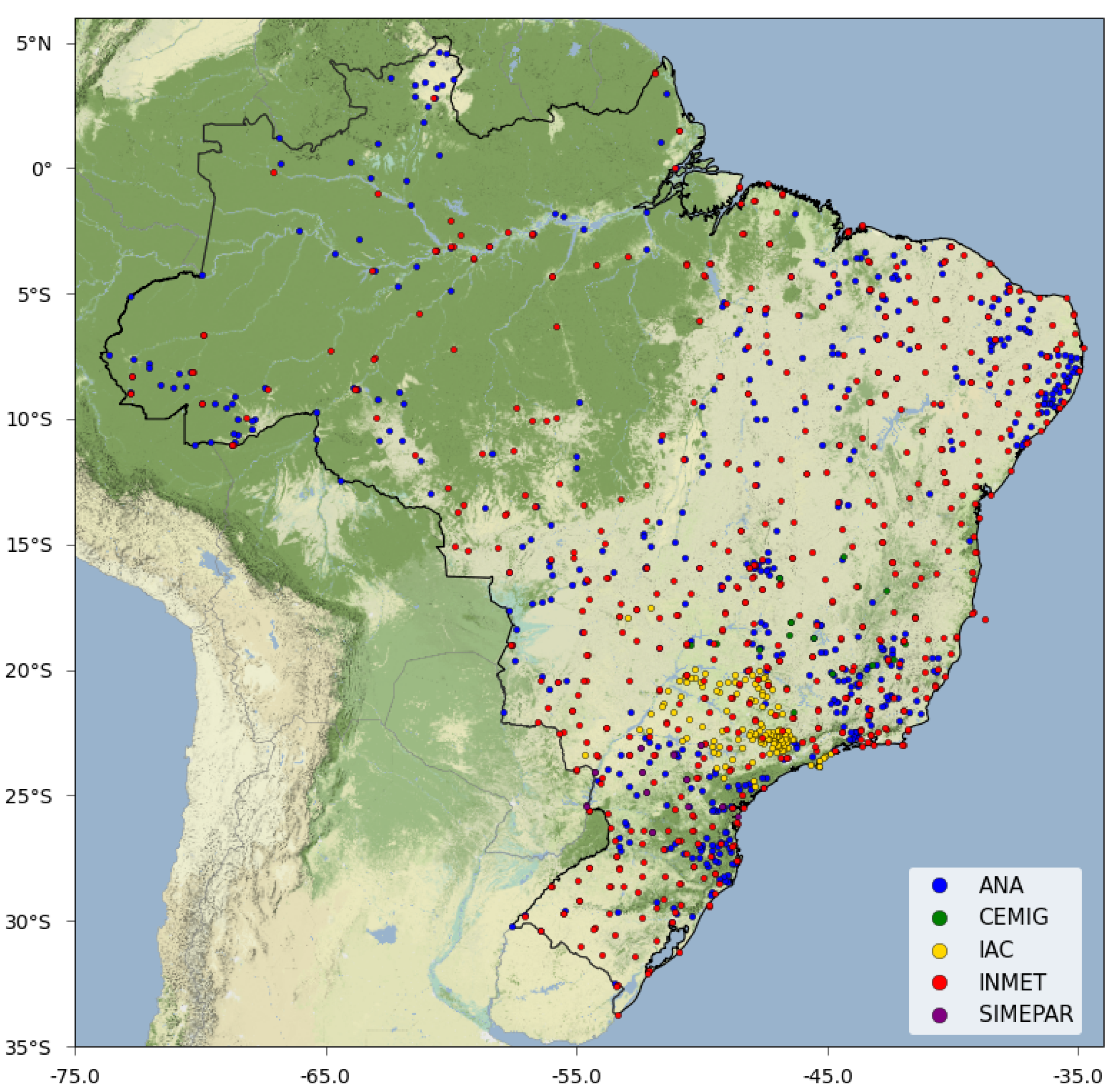
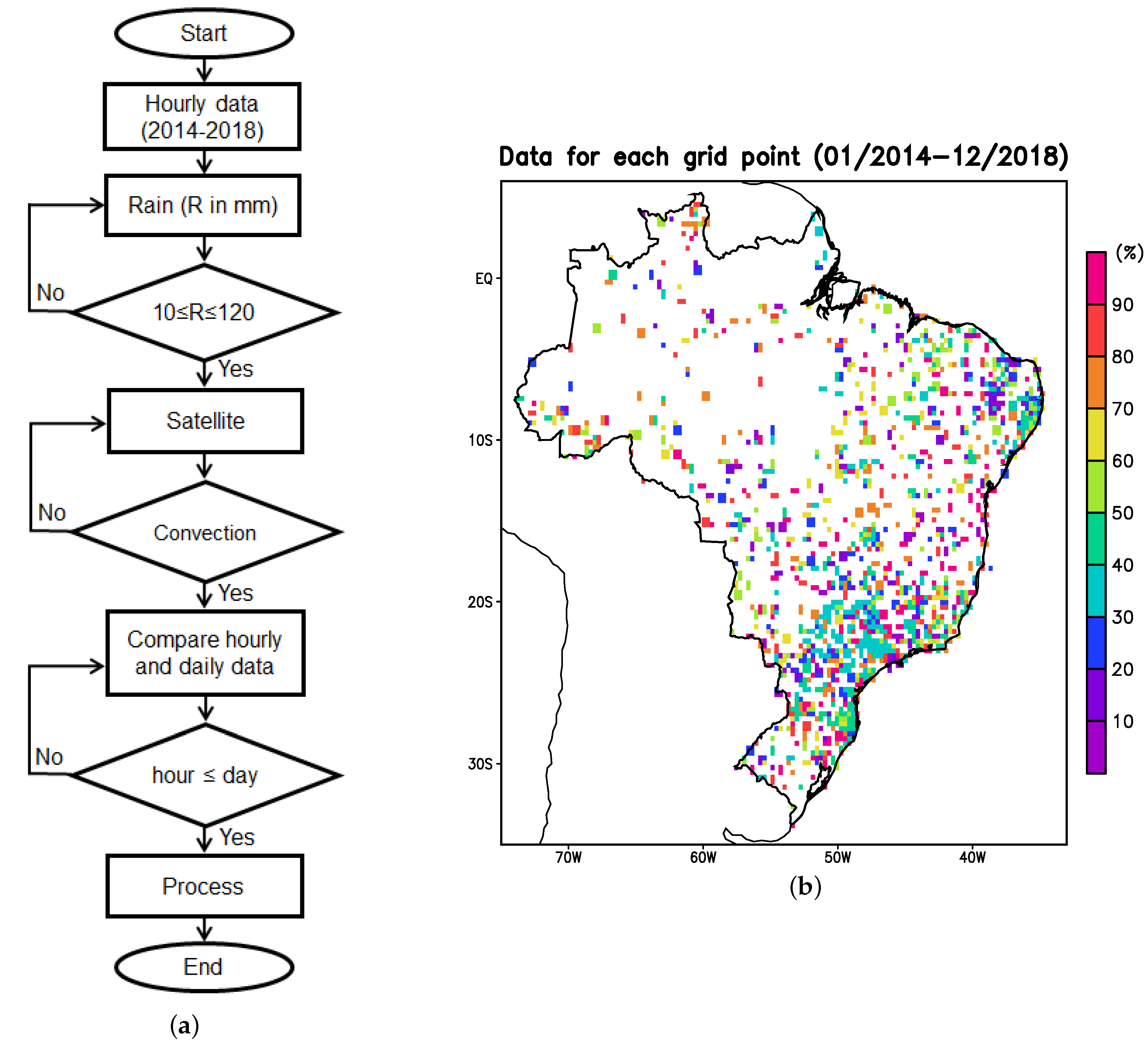
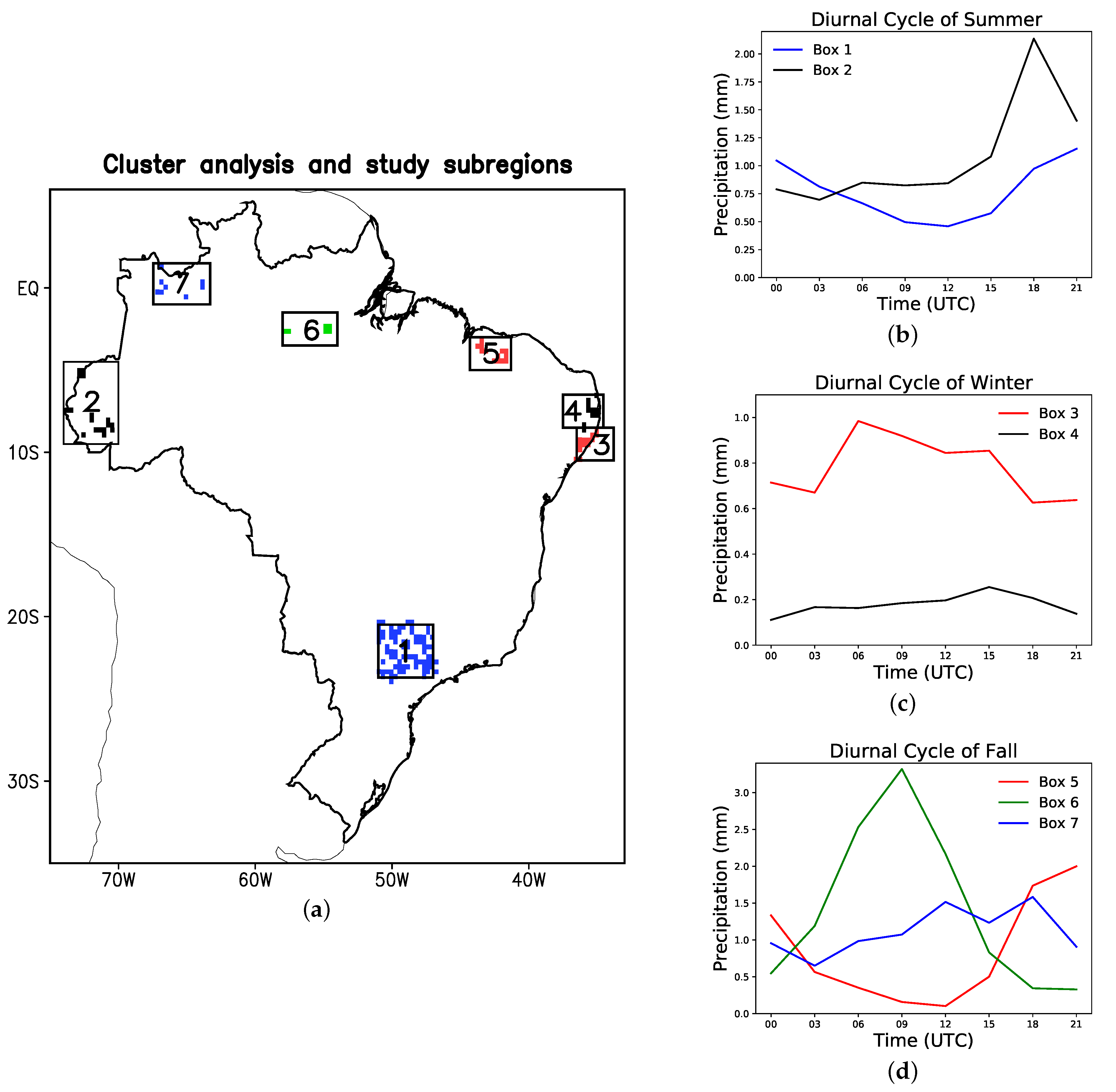
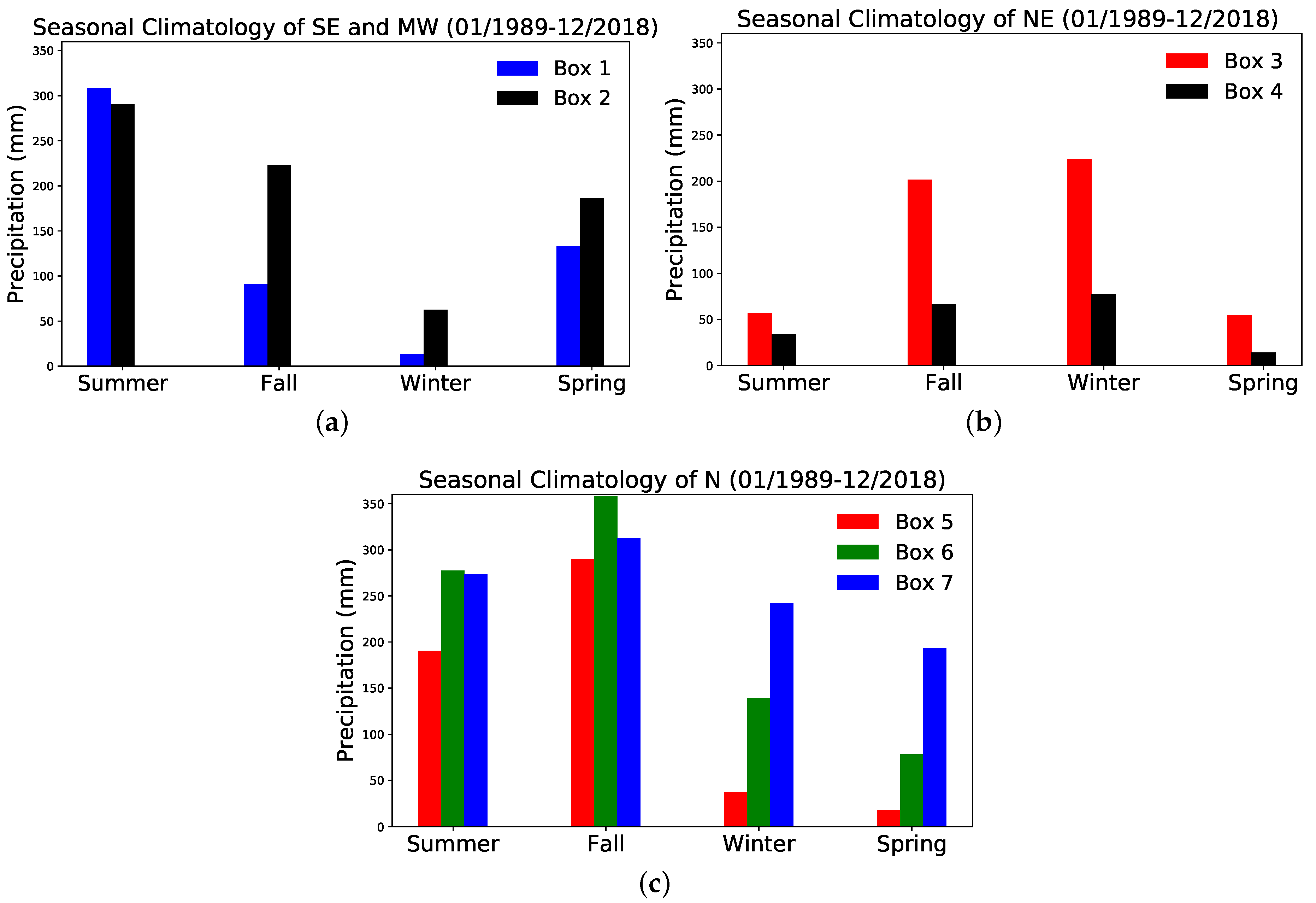

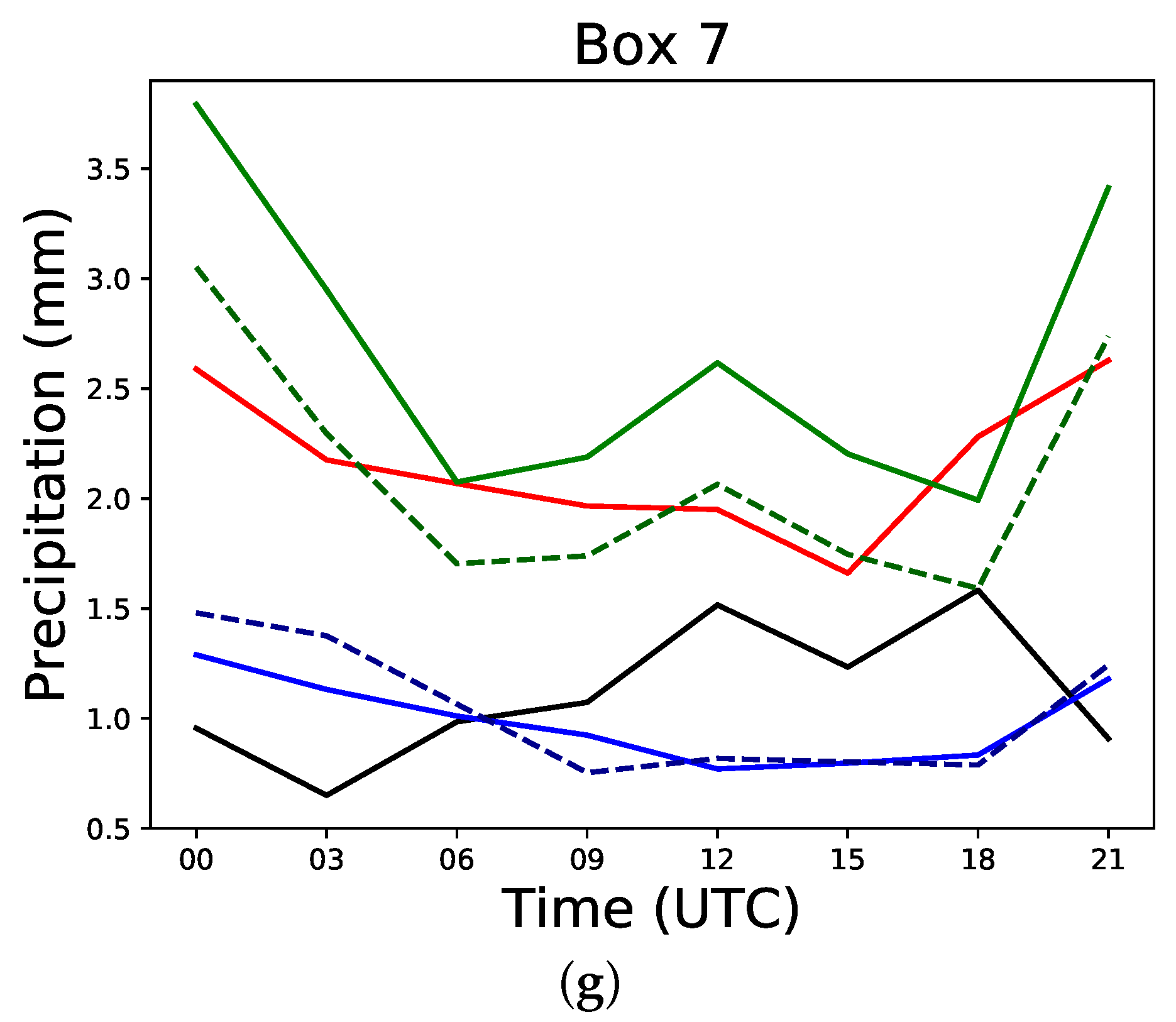

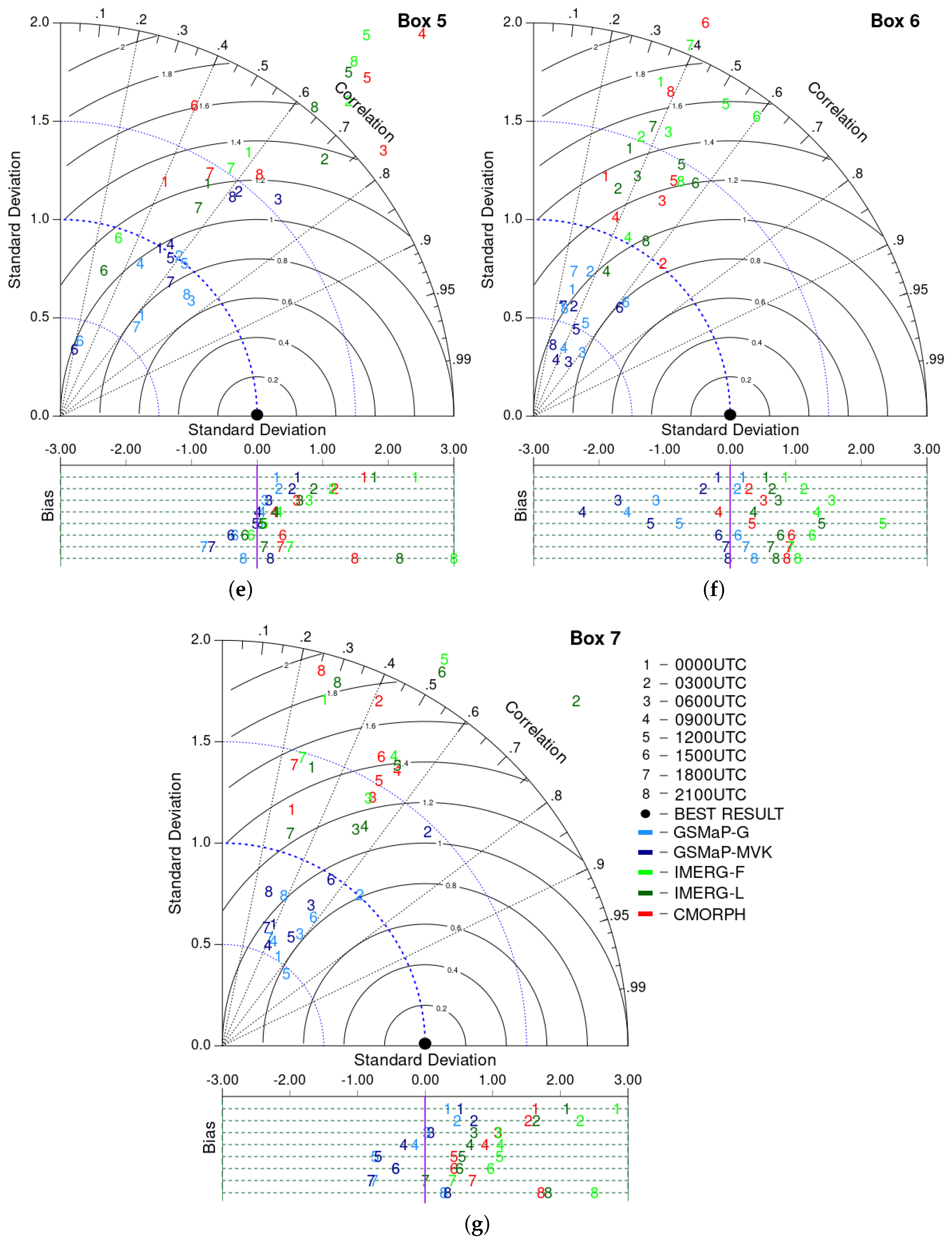
| Network | Coverage | Period | Resolution | Station N. |
|---|---|---|---|---|
| INMET | All Brasil | 2014–2018 | 1 h | 608 |
| ANA | All Brasil | 2014–2018 | 1 h | 504 |
| CEMIG | MG e GO | 2014–2018 | 1 h | 21 |
| IAC | SP | 2017–2018 | 20 min | 128 |
| SIMEPAR | PR | 2015–2018 | 3 h | 21 |
| Total | 1282 |
| Product | Period | Domain | Spatial Resolution | Temporal Resolution | Corrected by Gauges | Main Reference |
|---|---|---|---|---|---|---|
| GSMaP-G | 2014–present | 50°N–50°S | 0.1° × 0.1° | 1 h | Yes | [21] |
| (CPC daily) | ||||||
| GSMaP-MVK | 2014–present | 50°N–50°S | 0.1° × 0.1° | 1 h | No | [21] |
| IMERG-F | 2014–present | 60°N–60°S | 0.1° × 0.1° | 0.5 h | Yes | [24] |
| (GPCC monthly) | ||||||
| IMERG-L | 2014–present | 60°N–60°S | 0.1° × 0.1° | 0.5 h | No | [24] |
| CMORPH | 1998–present | 60°N–60°S | 0.08° × 0.07° | 0.5 h | No | [19] |
| Box | Region | Domain | Season | N. of Grid Points |
|---|---|---|---|---|
| 1 | SE | 23.70°–20.50°S; 51.00°–47.00°W | Summer | 80 |
| 2 | NW | 9.50°–4.50°S; 74.00°–70.00°W | Summer | 12 |
| 3 | NE | 10.50°–8.50°S; 36.50°–34.00°W | Winter | 13 |
| 4 | NE | 8.50°–6.50°S; 36.50°–34.00°W | Winter | 14 |
| 5 | N | 5.00°–3.00°S; 44.30°–41.30°W | Fall | 10 |
| 6 | N | 3.50°–1.50°S; 58.00°–54.00°W | Fall | 3 |
| 7 | N | 1.00°S–1.50°N; 67.45°–63.30°W | Fall | 8 |
| Statistic Index | Formula | Unit | Perfect Value |
|---|---|---|---|
| Correlation coefficient (CC) | – | 1 | |
| Root-mean-squared error (RMSE) | mm | 0 | |
| Normalized Standard Deviation (SD) | mm | 1 | |
| Bias | Bias = | mm | 0 |
| Box | Time | GSMaP-G | GSMaP-MVK | IMERG-F | IMERG-L | CMORPH | ||||||||||
|---|---|---|---|---|---|---|---|---|---|---|---|---|---|---|---|---|
| Bias | CC | SD | Bias | CC | SD | Bias | CC | SD | Bias | CC | SD | Bias | CC | SD | ||
| 1 | 00 | 0.14 | 0.81 | 1.00 | 0.34 | 0.75 | 1.33 | 1.63 | 0.75 | 2.45 | 0.97 | 0.74 | 1.84 | 1.10 | 0.74 | 2.14 |
| 03 | 0.22 | 0.82 | 1.18 | 0.40 | 0.68 | 1.70 | 1.00 | 0.76 | 2.15 | 0.57 | 0.75 | 1.66 | 0.74 | 0.72 | 2.07 | |
| 06 | 0.07 | 0.85 | 0.96 | 0.13 | 0.77 | 1.21 | 0.69 | 0.80 | 0.96 | 0.38 | 0.79 | 1.52 | 0.44 | 0.82 | 1.68 | |
| 09 | 0.02 | 0.87 | 0.88 | −0.01 | 0.83 | 0.99 | 0.69 | 0.88 | 2.20 | 0.43 | 0.85 | 1.72 | 0.30 | 0.84 | 1.57 | |
| 12 | −0.08 | 0.84 | 0.72 | −0.08 | 0.84 | 0.85 | 0.41 | 0.83 | 1.94 | 0.19 | 0.83 | 1.41 | 0.11 | 0.80 | 1.31 | |
| 15 | −0.17 | 0.79 | 0.85 | −0.23 | 0.72 | 0.98 | 0.23 | 0.78 | 1.52 | 0.02 | 0.78 | 1.06 | 0.40 | 0.71 | 1.48 | |
| 18 | −0.07 | 0.70 | 0.94 | 0.17 | 0.62 | 1.41 | 0.85 | 0.76 | 1.89 | 0.39 | 0.75 | 1.38 | 0.95 | 0.67 | 2.21 | |
| 21 | −0.03 | 0.78 | 0.82 | 0.13 | 0.73 | 0.98 | 1.73 | 0.67 | 2.30 | 1.01 | 0.66 | 1.67 | 1.56 | 0.66 | 2.12 | |
| 2 | 00 | 0.27 | 0.40 | 0.89 | 0.12 | 0.49 | 0.93 | 1.78 | 0.50 | 2.61 | 1.10 | 0.49 | 1.97 | 1.62 | 0.48 | 2.46 |
| 03 | 0.22 | 0.52 | 0.64 | 0.14 | 0.42 | 0.85 | 1.24 | 0.42 | 1.90 | 0.72 | 0.44 | 1.41 | 1.07 | 0.37 | 1.89 | |
| 06 | 0.16 | 0.67 | 0.77 | 0.09 | 0.65 | 0.95 | 0.94 | 0.54 | 1.55 | 0.49 | 0.57 | 1.17 | 0.81 | 0.66 | 1.43 | |
| 09 | 0.13 | 0.67 | 0.88 | −0.07 | 0.66 | 0.92 | 1.18 | 0.64 | 2.09 | 0.67 | 0.66 | 1.57 | 0.77 | 0.68 | 1.79 | |
| 12 | −0.07 | 0.60 | 0.67 | −0.25 | 0.61 | 0.70 | 1.48 | 0.69 | 2.66 | 0.88 | 0.70 | 2.02 | 0.53 | 0.65 | 1.55 | |
| 15 | −0.32 | 0.50 | 0.70 | −0.51 | 0.51 | 0.74 | 0.59 | 0.48 | 2.00 | 0.14 | 0.47 | 1.47 | 0.12 | 0.43 | 1.47 | |
| 18 | −1.14 | 0.41 | 0.48 | −1.40 | 0.27 | 0.47 | 0.40 | 0.32 | 1.25 | 0.30 | 0.31 | 0.91 | 0.24 | 0.43 | 1.27 | |
| 21 | −0.12 | 0.42 | 0.72 | −0.30 | 0.33 | 0.65 | 2.24 | 0.43 | 2.07 | 1.23 | 0.40 | 1.54 | 1.56 | 0.38 | 1.93 | |
| 3 | 00 | −0.41 | 0.77 | 0.52 | −0.67 | 0.72 | 0.15 | −0.22 | 0.64 | 1.73 | −0.54 | 0.62 | 0.61 | −0.57 | 0.45 | 0.45 |
| 03 | −0.31 | 0.51 | 0.71 | −0.65 | 0.38 | 0.06 | −0.38 | 0.39 | 1.29 | −0.57 | 0.38 | 0.44 | −0.47 | 0.44 | 0.70 | |
| 06 | −0.60 | 0.68 | 0.58 | −0.95 | 0.47 | 0.12 | −0.77 | 0.54 | 0.69 | −0.91 | 0.54 | 0.23 | −0.86 | 0.47 | 0.33 | |
| 09 | −0.50 | 0.71 | 0.67 | −0.86 | 0.41 | 0.26 | −0.58 | 0.44 | 1.27 | −0.81 | 0.44 | 0.42 | −0.84 | 0.34 | 0.22 | |
| 12 | −0.55 | 0.66 | 0.56 | −0.80 | 0.45 | 0.24 | −0.46 | 0.29 | 2.02 | −0.71 | 0.29 | 0.67 | −0.75 | 0.40 | 0.32 | |
| 15 | −0.60 | 0.72 | 0.45 | −0.81 | 0.57 | 0.16 | −0.13 | 0.62 | 2.39 | −0.59 | 0.59 | 0.89 | −0.48 | 0.37 | 2.31 | |
| 18 | −0.24 | 0.79 | 0.74 | −0.53 | 0.56 | 0.44 | 0.50 | 0.75 | 4.62 | −0.21 | 0.72 | 1.79 | −0.10 | 0.68 | 4.30 | |
| 21 | −0.28 | 0.79 | 0.69 | −0.58 | 0.77 | 0.30 | 0.18 | 0.73 | 3.60 | −0.33 | 0.72 | 1.53 | −0.36 | 0.70 | 1.32 | |
| 4 | 00 | 0.10 | 0.35 | 2.08 | −0.09 | 0.13 | 0.64 | 0.07 | 0.12 | 4.55 | −0.05 | 0.13 | 1.53 | −0.08 | 0.22 | 0.87 |
| 03 | 0.04 | 0.36 | 1.71 | −0.14 | 0.33 | 0.25 | 0.12 | 0.28 | 3.83 | −0.07 | 0.29 | 1.30 | −0.05 | 0.07 | 2.68 | |
| 06 | 0.07 | 0.27 | 2.45 | −0.12 | 0.29 | 0.75 | 0.06 | 0.27 | 4.13 | −0.09 | 0.27 | 1.39 | 0.00 | 0.12 | 3.43 | |
| 09 | 0.06 | 0.64 | 1.83 | −0.11 | 0.59 | 1.37 | 0.11 | 0.55 | 4.16 | −0.07 | 0.62 | 1.56 | −0.02 | 0.42 | 3.50 | |
| 12 | 0.03 | 0.57 | 2.22 | −0.10 | 0.38 | 2.26 | 0.06 | 0.59 | 4.20 | −0.08 | 0.64 | 1.77 | −0.02 | 0.32 | 3.99 | |
| 15 | −0.02 | 0.41 | 1.29 | −0.20 | 0.33 | 0.67 | 0.18 | 0.43 | 4.62 | −0.07 | 0.48 | 2.30 | 0.08 | 0.29 | 4.01 | |
| 18 | 0.06 | 0.55 | 1.46 | −0.14 | 0.49 | 1.00 | 0.36 | 0.60 | 6.94 | 0.03 | 0.56 | 3.36 | 0.25 | 0.61 | 6.29 | |
| 21 | 0.05 | 0.44 | 1.63 | −0.12 | 0.32 | 0.32 | 0.14 | 0.30 | 4.58 | −0.04 | 0.33 | 1.63 | 0.07 | 0.21 | 4.86 | |
| 5 | 00 | 0.29 | 0.63 | 0.66 | 0.62 | 0.51 | 0.99 | 2.42 | 0.58 | 1.65 | 0.79 | 0.53 | 1.40 | 1.63 | 0.41 | 1.31 |
| 03 | 0.33 | 0.60 | 1.02 | 0.53 | 0.62 | 1.46 | 1.14 | 0.68 | 2.17 | 0.87 | 0.72 | 1.88 | 1.19 | 0.47 | 2.49 | |
| 06 | 0.12 | 0.75 | 0.89 | 0.19 | 0.71 | 1.56 | 0.80 | 0.83 | 3.16 | 0.66 | 0.84 | 2.72 | 0.60 | 0.77 | 2.13 | |
| 09 | 0.07 | 0.47 | 0.88 | 0.01 | 0.54 | 1.04 | 0.34 | 0.61 | 3.29 | 0.29 | 0.64 | 3.18 | 0.27 | 0.69 | 2.68 | |
| 12 | 0.04 | 0.63 | 1.00 | −0.02 | 0.57 | 0.98 | 0.11 | 0.63 | 2.48 | 0.08 | 0.64 | 2.28 | 0.09 | 0.67 | 2.32 | |
| 15 | −0.34 | 0.25 | 0.40 | −0.40 | 0.21 | 0.35 | −0.10 | 0.31 | 0.95 | −0.18 | 0.29 | 0.77 | 0.39 | 0.40 | 1.72 | |
| 18 | −0.82 | 0.65 | 0.60 | −0.69 | 0.54 | 0.88 | 0.50 | 0.57 | 1.57 | 0.11 | 0.55 | 1.27 | 0.36 | 0.52 | 1.45 | |
| 21 | −0.21 | 0.72 | 0.89 | 0.21 | 0.62 | 1.42 | 3.01 | 0.64 | 2.34 | 2.18 | 0.64 | 2.03 | 1.49 | 0.64 | 1.59 | |
| 6 | 00 | 0.19 | 0.29 | 0.68 | −0.18 | 0.25 | 0.58 | 0.84 | 0.36 | 1.82 | 0.54 | 0.34 | 1.45 | 0.20 | 0.29 | 1.27 |
| 03 | 0.10 | 0.36 | 0.79 | −0.41 | 0.35 | 0.60 | 1.12 | 0.36 | 1.52 | 0.64 | 0.35 | 1.24 | 0.29 | 0.65 | 1.02 | |
| 06 | −1.13 | 0.61 | 0.41 | −1.70 | 0.54 | 0.33 | 1.55 | 0.43 | 1.60 | 0.73 | 0.40 | 1.33 | 0.51 | 0.51 | 1.28 | |
| 09 | −1.57 | 0.41 | 0.38 | −2.25 | −0.37 | 0.31 | 1.32 | 0.47 | 1.03 | 0.36 | 0.45 | 0.82 | −0.17 | 0.38 | 1.10 | |
| 12 | −0.77 | 0.49 | 0.54 | −1.21 | 0.44 | 0.49 | 2.32 | 0.52 | 1.86 | 1.40 | 0.51 | 1.49 | 0.34 | 0.51 | 1.40 | |
| 15 | 0.12 | 0.63 | 0.75 | −0.17 | 0.62 | 0.71 | 1.25 | 0.60 | 1.90 | 0.77 | 0.57 | 1.44 | 0.94 | 0.40 | 2.18 | |
| 18 | 0.24 | 0.27 | 0.77 | −0.07 | 0.26 | 0.58 | 0.92 | 0.39 | 2.05 | 0.62 | 0.38 | 1.60 | 0.90 | 0.06 | 3.29 | |
| 21 | 0.37 | 0.28 | 0.57 | −0.03 | 0.26 | 0.38 | 1.03 | 0.53 | 1.41 | 0.70 | 0.54 | 1.06 | 0.86 | 0.39 | 1.79 | |
| 7 | 00 | 0.33 | 0.53 | 0.52 | 0.52 | 0.39 | 0.65 | 2.84 | 0.28 | 1.78 | 2.10 | 0.31 | 1.44 | 1.63 | 0.28 | 1.22 |
| 03 | 0.48 | 0.67 | 1.01 | 0.73 | 0.69 | 1.46 | 2.30 | 0.74 | 3.35 | 1.65 | 0.72 | 2.44 | 1.53 | 0.41 | 1.87 | |
| 06 | 0.03 | 0.57 | 0.67 | 0.08 | 0.53 | 0.82 | 1.09 | 0.51 | 1.42 | 0.72 | 0.52 | 1.26 | 1.08 | 0.52 | 1.43 | |
| 09 | −0.15 | 0.44 | 0.58 | −0.32 | 0.41 | 0.55 | 1.12 | 0.51 | 1.66 | 0.67 | 0.54 | 1.29 | 0.89 | 0.54 | 1.61 | |
| 12 | −0.75 | 0.67 | 0.48 | −0.70 | 0.54 | 0.63 | 1.10 | 0.50 | 2.20 | 0.55 | 0.53 | 0.63 | 0.43 | 0.51 | 1.52 | |
| 15 | −0.44 | 0.58 | 0.78 | −0.43 | 0.55 | 0.98 | 0.97 | 0.44 | 2.84 | 0.51 | 0.51 | 2.14 | 0.43 | 0.48 | 1.63 | |
| 18 | −0.75 | 0.40 | 0.58 | −0.80 | 0.35 | 0.62 | 0.41 | 0.27 | 1.48 | 0.01 | 0.31 | 1.10 | 0.70 | 0.25 | 1.43 | |
| 21 | 0.27 | 0.38 | 0.80 | 0.33 | 0.29 | 0.79 | 2.50 | 0.33 | 2.41 | 1.83 | 0.30 | 1.88 | 1.72 | 0.25 | 1.92 | |
© 2020 by the authors. Licensee MDPI, Basel, Switzerland. This article is an open access article distributed under the terms and conditions of the Creative Commons Attribution (CC BY) license (http://creativecommons.org/licenses/by/4.0/).
Share and Cite
Afonso, J.M.d.S.; Vila, D.A.; Gan, M.A.; Quispe, D.P.; Barreto, N.d.J.d.C.; Huamán Chinchay, J.H.; Palharini, R.S.A. Precipitation Diurnal Cycle Assessment of Satellite-Based Estimates over Brazil. Remote Sens. 2020, 12, 2339. https://doi.org/10.3390/rs12142339
Afonso JMdS, Vila DA, Gan MA, Quispe DP, Barreto NdJdC, Huamán Chinchay JH, Palharini RSA. Precipitation Diurnal Cycle Assessment of Satellite-Based Estimates over Brazil. Remote Sensing. 2020; 12(14):2339. https://doi.org/10.3390/rs12142339
Chicago/Turabian StyleAfonso, João Maria de Sousa, Daniel Alejandro Vila, Manoel Alonso Gan, David Pareja Quispe, Naurinete de Jesus da Costa Barreto, Joao Henry Huamán Chinchay, and Rayana Santos Araujo Palharini. 2020. "Precipitation Diurnal Cycle Assessment of Satellite-Based Estimates over Brazil" Remote Sensing 12, no. 14: 2339. https://doi.org/10.3390/rs12142339
APA StyleAfonso, J. M. d. S., Vila, D. A., Gan, M. A., Quispe, D. P., Barreto, N. d. J. d. C., Huamán Chinchay, J. H., & Palharini, R. S. A. (2020). Precipitation Diurnal Cycle Assessment of Satellite-Based Estimates over Brazil. Remote Sensing, 12(14), 2339. https://doi.org/10.3390/rs12142339






